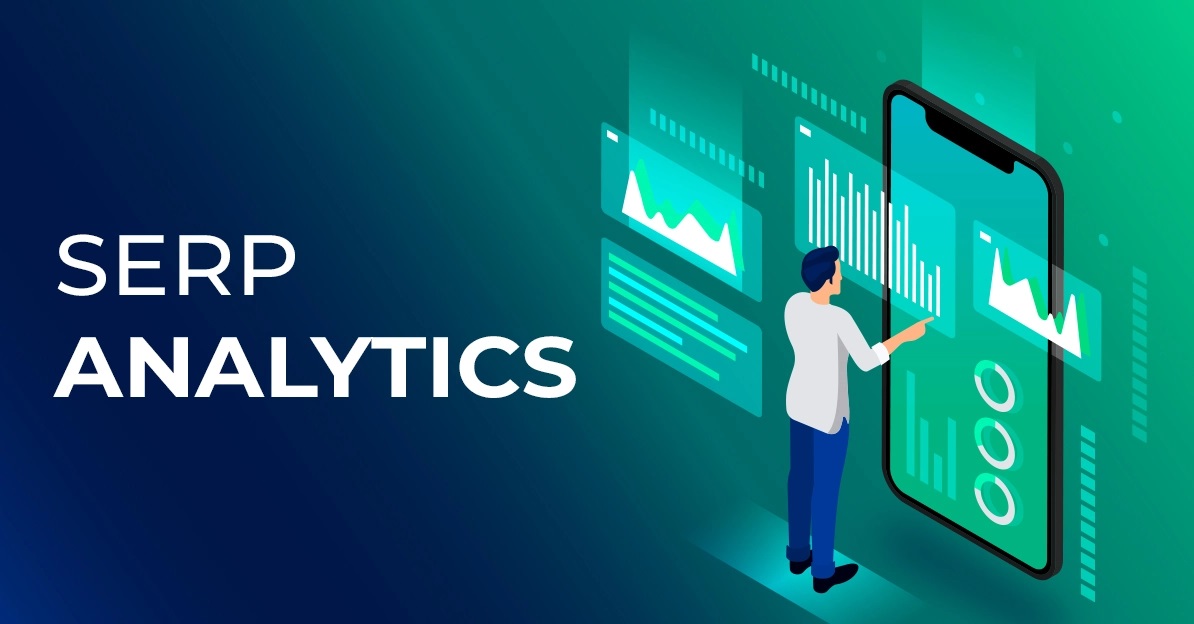
In today’s competitive market, marketers or businesses need to focus heavily on their SEO marketing efforts and generate traffic on Google where Competitive SERP Analytics plays an important role. It provides a better understanding of your SERP strategy to gain a competitive advantage. With the increasingly populated SERP and Google’s rapidly changing algorithm, it’s crucial to analyze competitive Search Engine Results Pages and aim to appear in all available SERP components for your website to rank high and stay on top of the ever-changing search results.
This article will give you valuable insights into how to rank your website, be able to optimize your website, apply the results to your own search engine optimization (SEO) strategy along with an understanding for marketers to familiarize themselves with the importance of competitive SERP Analytics.
Look at our Real-time SERP Track Changes. Google Market Pulse for Apparel & Accessories
What is Competitive SERP Analysis?
Competitive SERP analysis is the process of monitoring, tracking, and analyzing brands, businesses, and companies that compete with you on the digital shelf to strategize and stay one step ahead of the competition. It’s all about paying close attention to how competitors’ results are displayed on the SERP to get an idea of what works so you can incorporate the best pieces for SERP listings into your own best practices.
Competitive Google SERP analysis allows you to examine the overall search results and determine the search intent for the keyword so you can maximize your opportunities to rank for relevant keywords and outrank your competitors. It helps you make smarter decisions about the type of content you should be implemented within your website to increase your SERP visibility and rank.
Why is Competitive SERP analysis Important?
Competitive SERP Analytics is a necessary extension of traditional SERP analytics to solve challenges and uncover opportunities in the market. It helps businesses uncover key insights which are otherwise hidden and is insufficient in today’s ultra-competitive digital marketing space merely from the respective search platform data.
Our competitive SERP analysis aids you in identifying what metrics are important to ensure you use the most relevant & valuable keywords, understand the search intent, find gaps in the content served, and identify your competitors in each SERP to generate better content and improve your rankings.
Benefits of Competitive SERP Analysis
Listed below are the several benefits and insights you can get from Competitive SERP Analytics:
- Opportunities to Beat Competitors
- Threats to Organic Traffic
- Planning the Right Content for Relevant and Valuable Keywords
- Other SERP Feature Opportunities
- Gain Insights on Competitive Pricing Data
- Get Insights from a Comprehensive Keyword Research
- Smart Budget Mobilization and Cost Control
- Avoid Cannibalization Issues
Before diving into the details, look at our SERP Feature Trend Reports for Apparel & Accessories.
Let us discuss this more in detail.
1. Opportunities to Beat Competitors
Competitive SERP analysis is used while performing comprehensive keyword research to understand the search intent of relevant keywords. It is done by analyzing the SERP content for a keyword. And its results will tell you the search engine is understanding the intent of the keyword.
For example: Consider a long-tail keyword phrase “Best Outdoor Wireless Camera”. The SERP content for this keyword showed that 9 of the 10 SERP results are blog articles. This implies that Google considers the intent of this keyword as the “research/interest” phrase. Therefore, to compete with this keyword phrase, the chances of ranking higher increase with informational content, rather than a product page or a category page.
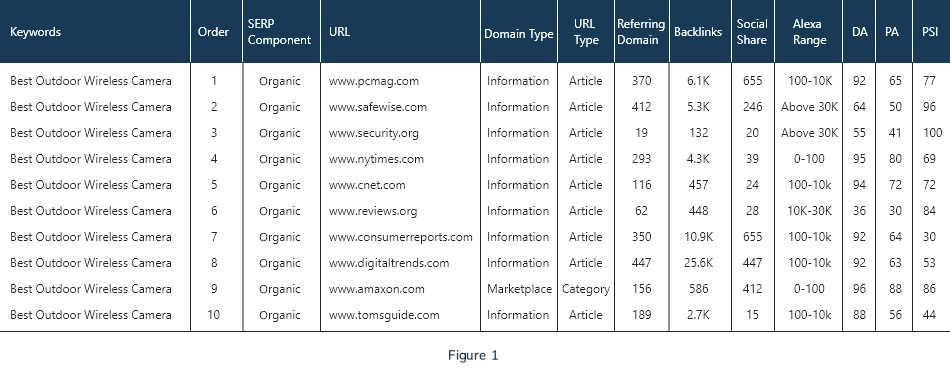
Besides keyword planning and research, competitive SERP analysis also helps to figure out how competitive the keyword is, based on metrics such as: “Referring Domains,” “Backlinks”, “Social Sharing”, and “Domain Authority” of each ranking page. If your website has better metrics than your competitors, you will have a much better chance of displacing them with your highly optimized relevant content
2. Threats to Organic Traffic
In Fig 2 below the keyword phrase “Best Outdoor Wireless Camera” is shown above the fold of organic results in February. However, “Google Shopping Ads” is shown above the fold in March for the same keyword. This means that other competitors took the opportunity to outrank the organic results by focusing on Google Shopping Ads.
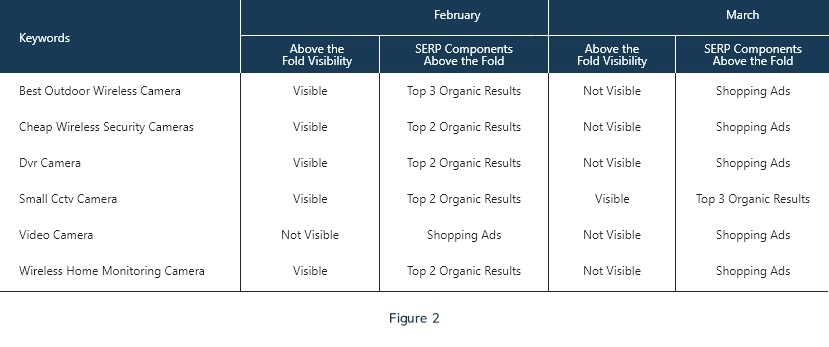
Marketers should optimize and plan to get to the top results of the SERP. After all organic results have the highest chance of getting clicks than other SERP features. After analyzing the real-time SERP data, we found that big brands are always trying to rank on various SERP components to increase their Share of Search on Google.
3. Planning the Right Content for Relevant and Valuable Keywords:
Using competitive SERP analysis, you can plan the right content compared to your top competitors in the SERP and find out what your competitors’ results are for certain keywords. We categorized the top competitors by URL and Domain Type. Selected electronics keywords were categorized like such:

The collected data were categorized based on URL and Domain Type to present them as competitors and non-competitors.
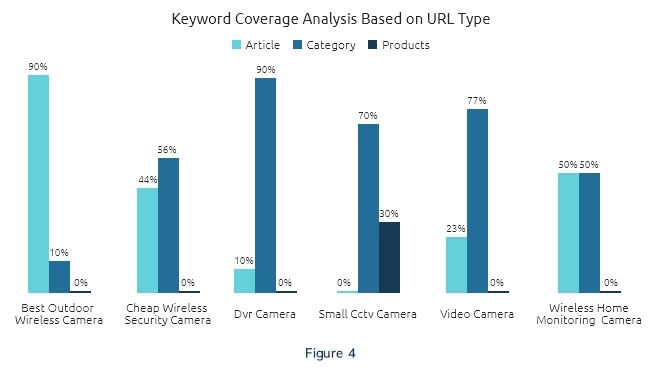
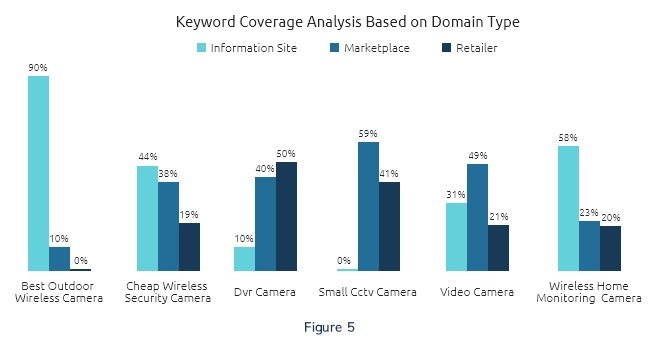
Per the image above, the keyword “Best Outdoor Wireless Camera”, 90% of the top results show URL type – “Article” page and Domain type – “Informational Sites”. This infers that 90% of SERP results are showing article-based results from Informational Sites (Non-Competitors).
However, if we look at the keyword “Small Cctv Camera”, 59% of top results show Marketplace and 41% show Retailers with no Informational Site in Domain Type. Whereas 70% of the top results show Category as URL Type and 30% show the Product Detail page with no Articles under URL Type. This infers that 100% of the top results are product competitors.
What can be done:
- Create or plan “Informational Content” to target specific keywords with better content, optimization, and fulfill gaps in the market and the needs of the users.
- If you meet the criteria of having a high social share and Referring domains, then you can compete with product detail or listing pages.
- You can target either Text or Shopping Ads by properly optimizing your product details and contents and keyword bids. You can target “People Also Ask” SERP features using informational-based pages and content.
4. Other SERP Feature Opportunities
Competitive SERP analysis can help webmasters to evaluate the status of their focused keywords and their relevancy in terms of competitors. You can easily find opportunities on SERPs that can help you create a holistic search strategy. In-depth competitive SERP analysis helps to figure out what type of SERP features are being displayed by search engines and available for specific search queries and intents.
For example, the keyword phrase “Best Outdoor Wireless Camera” displays People Also Ask, Popular Products, and Sponsored Ads on their organic results. This signifies that there are opportunities for other SERP features such as “Featured Snippets”, “Videos”, or “Popular Tweets”, which can be obtainable through targeted efforts on specific SERP components.
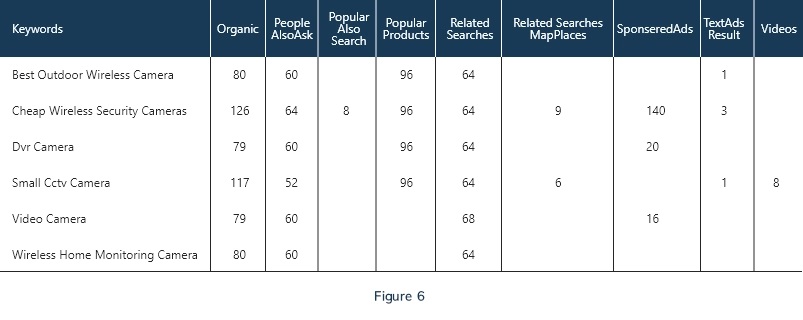
5. Gain Insights into Competitive Pricing Data
Competitive SERP Analytics gives you pricing data on your and your competitor’s products. This allows you to make pricing decisions like increasing the CPC on products where you have the lowest price on the auction to rapidly increase your sales volume. Competitive pricing data provides insights on various metrics including conversion rate, customer acquisition cost, ROI, ROAS, maximum bid per click, Quality Score of your ad, and the ad rank of competitors targeting the same keywords.
With our competitive pricing data, advertisers on Google can identify products that are candidates for price decreases. Google Shopping advertisers can take advantage of higher CPC prices if it results in profitable conversions and a positive overall ROAS. For example, if you have a conversion rate of 1% with a $1 average CPC and a conversion rate of 2.5% with an average CPC of $1.6, you should go with the higher CPC as it has a higher conversion rate.
6. Get Insights from Comprehensive Keyword Research
Performing comprehensive keyword research allows you to go beyond just search volume. It allows you to better understand your audience, know the search intent of the keywords, recognize the SERP features to target, and identify which keywords you already get traffic on, and which keywords need improvements. This type of insight lets you pick the most relevant keywords for your niche to rank on the highest number of possible keywords.
Additionally, competitive SERP data allows you to see which stage of the funnel the shopper is at based on the search query result. As an advertiser, you can make strategic decisions based on these insights. Such as:
- Advertisers can reduce shopping ads on keywords without competition and instead optimize product titles, product descriptions, and product detail pages, highlighting the product’s best features, providing the most affordably priced product, and using high-quality images to focus on building strong SEO.
- You can focus on SEO to rank on organic search results for top-of-the-funnel keywords where the shopper is at the research stage of their purchase journey.
- Advertisers can target shopping ads toward the shopper that are in the latter stages of their shopping journey for the high-volume bottom-of-the-funnel keywords to increase their chances of the conversation.
- And advertisers can prioritize optimizing text ads for those mid-funnel keywords where users are looking for additional information about the product or service.
7. Smart Budget mobilization and cost control
Competitive analysis as a part of your strategic planning allows advertisers to bid for the keywords that are relevant to their niche, smartly mobilize their budget, and compare themself against both their direct and indirect competition to rank in a better SERP position.
Competitive SERP analysis also helps you uncover potential opportunities in the marketplace by providing you with data on areas like website traffic, paid ads, organic performance, social media, and content. Businesses can utilize this data and insights to better understand their competitive landscape, market overview, and visibility on the digital shelf. Additionally, you can gain insights into your competitor’s keyword strategies, effective marketing channels, and content optimization ideas.
8. Avoid cannibalization issues
We are aware that search engines would rank several pages of a single website for the same target keyword. In such cases, the competitive SERP ranking analysis tools help you see how search engines move pages up and down for a given keyword.
For example, Apple has several web pages competing for the same keyword. As a result, the search engine is unable to understand which page is to be ranked higher. This can prevent your pages from getting top rankings so, you can take advantage of data from competitive SERP analytics to track and avoid cannibalization issues within and across SERP features and build a better promotional strategy.
How do You Monitor Competitive SERP Analysis?
The steps to monitor competitive SERP analysis include:
- Study the click data for possible traffic
Due to the increased popularity of SERP features the number of no-click searches has been increasing. So, you need to check and verify that people visit the targeted SERP and are clicking on a result. You can check the click metrics to see the number of clicks, search volume, target keywords, and the search volume with a reasonable number of searches to make sure you picked relevant keywords for your niche.
Also, you can perform an opportunity analysis to achieve the target of increasing clicks and traffic by using keywords that your competitor sites are not ranking for and looking for keywords that have the potential to rank higher in SERPs.
- Check page rankings and content type
Understanding intents helps you present relevant content in front of users that matches their searches. You can check user intent by checking the SERP for your keyword, and scan URLs, titles, and snippets to focus on the results shown on the top to understand the types of intent they serve. After understanding searcher intent and seeing how your content is ranking against your competitors for search queries, SERP Analyzer helps you get the right content type and choose your content type based on the results.
- Measure the competitiveness
To better understand the competition, you need to measure the competitiveness by looking at link authority and content. Check competitor sites’ page-level authority and domain authority, and crawl the pages to compare and analyze keyword difficulty, and competitors with high domain authority, and ensure that your page is more likable than your competitors’ content. Along with the link authority, you can measure domain difficulty, page difficulty, and content score as well.
- Check ranking opportunities across the SERP feature
If the SERP features are showing for your keywords or query you should start working to show up on them across paid or organic results. SERP features include featured snippet opportunities, people also ask, video carousel, news, image pack, etc. You can target each feature as a part of your strategy to grab an opportunity to rank on the top of the page and outrank your competitors. With SERP feature analysis, you can see the SERP features available for the keyword you are tracking and monitor a keyword you are targeting, helping you spot opportunities on the SERP to rank higher.
- Keep up with Volatility
As the SERP is ever-changing, to maintain your top organic position you need to monitor and keep up to date with potential changes so that you can address the change that affects your position on the SERP. You need to monitor the volatility of different search results to know about SERP ranking fluctuation to understand the volatility of each keyword by using a rank tracker that offers the best way to analyze SERP competitors.
Conclusion
So, all in all, a competitive SERP analysis is fundamental to start you on the right path to understanding how Google reads important SEO data and what elements influence how web pages are displayed on the search results page. It helps you find places to optimize and outrank competitors by allowing you to improve your SEO strategy.
Search Intelligence software is a powerful tool that allows you to gain unified insights into data on SERP components such as threats or opportunities above the fold, SERP Features, Organic opportunities, Competitor SERP Status, etc. It is an extension to the conventional SERP analytics uncovering current SEO challenges and opportunities across your various target locations and devices. It helps you with Competitive SERP analysis to gain a competitive edge, with holistic visibility into Search, Product, and Marketplace intelligence.
Learn more about it more on “What is Search Intelligence”
Originally published at https://growbydata.com on April 25, 2022.

